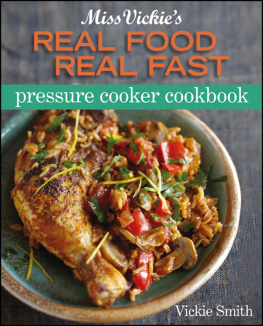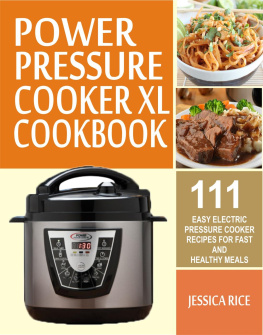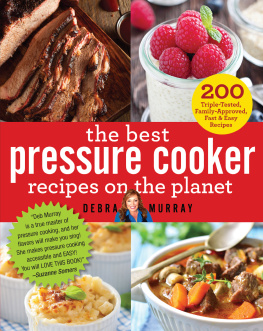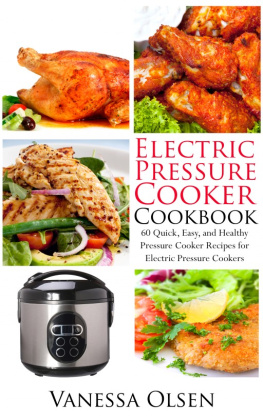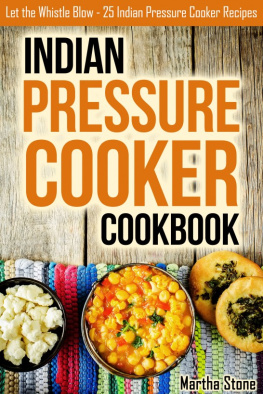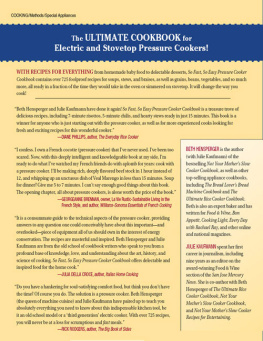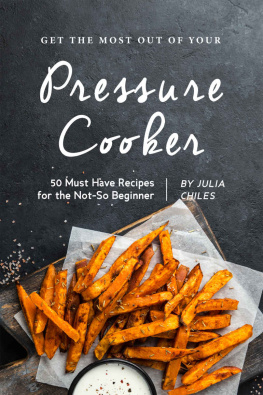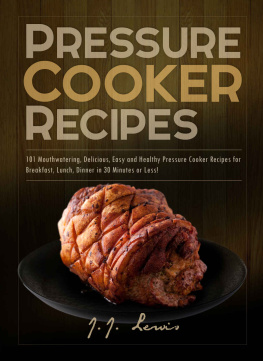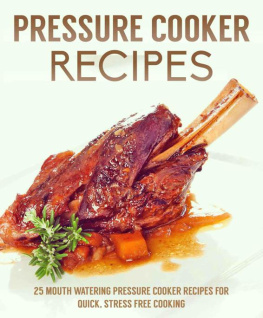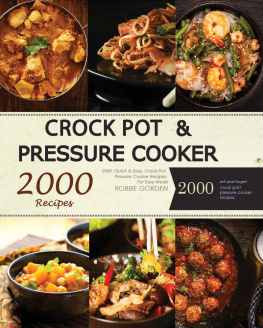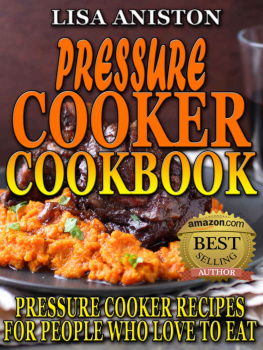Copyright 2013 by Vickie Smith. All rights reserved.
Cover and interior photography copyright 2013 by Jason Wyche.
Cover design by Suzanne Sunwoo
Published by Houghton Mifflin Harcourt, New York, New York.
For information about permission to reproduce selections from this book, write to Permissions, Houghton Mifflin Harcourt Publishing Company, 215 Park Avenue South, New York, New York 10003.
www.hmhbooks.com
Library of Congress Cataloging-in-Publication Data
Smith, Vicki (Vicki L.), 1947
Miss Vickies pressure cooker, real food real fast/Vickie Smith; photography by Jason Wyche.
p. cm.
Includes index.
ISBN 978-0-470-87342-7 (pbk.); ISBN 978-0-544-18741-2 (ebk.)
1. Pressure cooking. I. Title.
TX840.P7.S654 2013
641.587dc23
2012017464
v1.0413
introduction
All over America, cooks are once again rediscovering the benefits of modern pressure cookery. Todays advanced pressure cookers are a far cry from our grandmothers unreliable vintage models. These new time-saving appliances are completely reengineered, completely safe, and ultra-reliablein short, goof-proof. They are designed to appeal to busy cooks with hectic schedules, demanding jobs, active families, and little spare time for cooking. The modern pressure cooker is the perfect solution for anyone looking for healthier recipes and faster, economical ways to prepare nutritious home-cooked meals.
A tremendous variety of different foods and types of recipes can be cooked in just minutes in the pressure cooker. In this book Ive included more than two hundred recipes for everything from breakfast to dessert, from quiches to cakes. There are family-friendly one-pot stews, roasts, and casseroles as well as multicourse feasts for company. There are also shortcut recipes, nutritious and superfast versions of kitchen staples like chicken soup, mac and cheese, and tuna casserole. And there are recipes for snacks, starters, sides, and sauces.
So forget about Grandmas stories of exploding pressure cookers and those old tales about dinner decorating the kitchen ceiling or family dinners consisting of mush. The old-style, noisy, hissing pressure regulators have become a distant memory, a relic of bygone days. Say goodbye also to hot ovens and standing in front of a stove, constantly watching and stirring a pot. Its time to take a good look at todays new pressure cooker. Join the many happy people who are discoveringor rediscoveringthe completely safe and very easy-to-use modern pressure cooker.
pressure cooker
tips, techniques, and equipment
All pressure cookers operate by the same principle. The pot is an enclosed system. Heat builds steam, which produces the pressure needed to cook the food faster. The pressure is controlled by adjusting the heat. Safety devices are designed to vent of excess pressure, and the pressure must be released before opening the lid. Thats it in a nutshell.
Getting Started
Be sure to thoroughly read the owners manual to familiarize yourself with the basic principles, new terminology, and techniques associated with pressure cookery. Keep the manual in a safe place for quick reference. If you have lost the original owners manual that came with your cooker, replacements are often available at little or no cost by contacting the manufacturer.
BEFORE YOU BEGIN
You should carefully inspect your pressure cooker prior to each and every use. Make sure that it is clean inside and out. Lift or turn the pressure valve to make sure it moves freely, and check the housing assembly or connecting screw to see that it is secure. Examine the vent pipe if your cooker uses the classic jiggle-top pressure regulator, making sure its clean and open. Check the handles on the pot and the lid to confirm that they are firmly attached, tightening the screws as necessary. The gasket and other replaceable rubber or silicone seals should be in good condition, with no signs of tears or other deterioration such as gumminess or brittleness. Replace the parts if there are any suspicious areas or other signs of deterioration. The gasket should fit snugly in its place in the lid.
FOLLOW RECIPE DIRECTIONS
Always use a pressure cooker recipe for the correct timing and release method. Dont rely on guesswork when it comes to pressure cooking. A mistake in choosing the proper cooking method, timing, or release method will yield unsatisfactory results in short order.
ADDING LIQUID TO THE PRESSURE COOKER
Before starting to cook anything in a pressure cooker, there must be some sort of liquid inside the pot to generate enough steam to pressurize the cooker. The minimum amount of water or liquid required depends on two factors: (1) the length of cooking time, and (2) the cooking method; it does not depend on the amount of food in the pressure cooker. Modern pressure cookers can use as little as less than cup of water or other cooking liquids, but check the owners manual for the minimum amount as recommended by the manufacturer. This amount of liquid recommended is usually sufficient for about 15 minutes of pressure-cooking time, and longer cooking times will require correspondingly more liquid.
FILLING THE PRESSURE COOKER
Never exceed the maximum fill level on any pressure cooker. Some units have these maximum fill levels conveniently marked on the inside of the pot. Do not exceed the two-thirds full level for most ingredients. The exceptions are foods that are mostly liquids, and foods that foam, froth, or expand during cooking (see ), in which case the maximum is only half full.
PRESSURIZING THE COOKER
Place the pressure cooker on the correct size burner, which means one that is no larger, or is slightly smaller, than the diameter of the cooker base. Do not use a burner that is larger or a super-high BTU heating element. Set the heat on high initially, to rapidly pressurize the cooker. Once high pressure (15psi) is reached, as shown by the pressure indicator, immediately lower the heat to the lowest possible setting that will stabilize and still maintain pressure. Now its time to begin actually timing the cooking according to the recipe directions.
Cooking and Timing
If using a model with the classic pressure regulator, or jiggle top, it should rock three to five times per minute. If it is in constant motion, the heat is too high and it needs to be adjusted to a lower setting. As with any other cooking method that uses high heat, such as frying, broiling, or grilling, the pressure cooker should not be left unattended. Alwayslet me repeat thatalways use a timer. A digital timer is preferred because it can be carried with you on a lanyard, clipped on a belt, or pocketed so you will never forget about the pressure cooker. When the cooking time is up, remove the pressure cooker from the heat source and proceed with the release method recommended in the recipe.
RELEASING PRESSURE
Before the lid can be removed from the pressure cooker, the pot must be depressurized. This is an important element of pressure cooking, and the choice of pressure release methods can have a great impact on the food inside the cooker. There are three methods (see ) for releasing the pressure in a modern stovetop pressure cooker: (1) the natural release method, (2) the quick release method, and (3) the cold water release method. Using the correct pressure release method is the final phase of pressure cooking and affects the successful outcomes of most recipes. Individual recipes will indicate which release method to use at the end of the cooking process.

